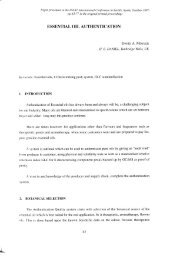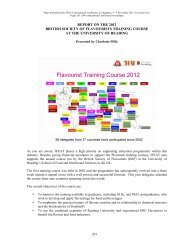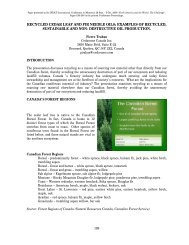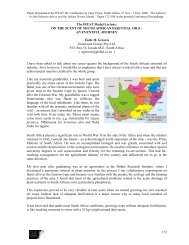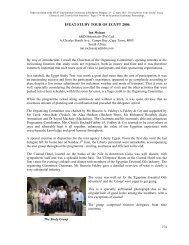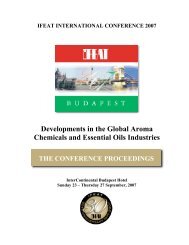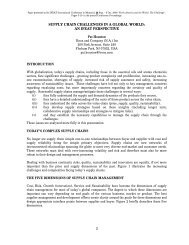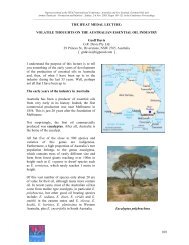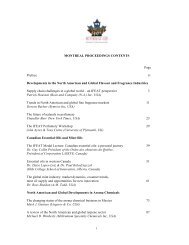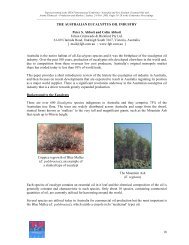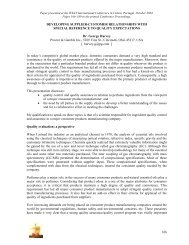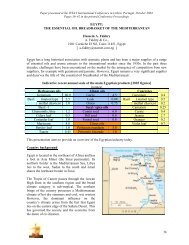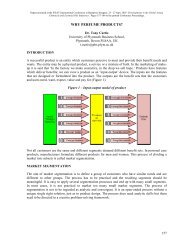Paper presented at the IFEAT Int. Conference in Cape Town
Paper presented at the IFEAT Int. Conference in Cape Town
Paper presented at the IFEAT Int. Conference in Cape Town
Create successful ePaper yourself
Turn your PDF publications into a flip-book with our unique Google optimized e-Paper software.
much closer rel<strong>at</strong>ed to th<strong>at</strong> of A. crenul<strong>at</strong>a, although it does conta<strong>in</strong> elements of A. betul<strong>in</strong>a oil aswell). A third school of thought doubts its existence altoge<strong>the</strong>r, ascrib<strong>in</strong>g <strong>the</strong> chemistry of a buchu oilconta<strong>in</strong><strong>in</strong>g characteristics of both species to <strong>the</strong> distill<strong>at</strong>ion of both A. betul<strong>in</strong>a and A. crenul<strong>at</strong>a plants<strong>in</strong> one b<strong>at</strong>ch. S<strong>in</strong>ce <strong>the</strong> identific<strong>at</strong>ion of all <strong>the</strong> components found <strong>in</strong> buchu oil <strong>in</strong> 1975 [4] and <strong>the</strong>development of accur<strong>at</strong>e analytical GC analyses of buchu oils obta<strong>in</strong>ed from s<strong>in</strong>gle plants with<strong>in</strong>South Africa <strong>in</strong> <strong>the</strong> early 1990s, it has been shown th<strong>at</strong> A. betul<strong>in</strong>a x crenul<strong>at</strong>a certa<strong>in</strong>ly does exist.Whe<strong>the</strong>r it is a true hybrid, or a popul<strong>at</strong>ion / chemotype of A. crenul<strong>at</strong>a still rema<strong>in</strong>s unclear.It has to be stressed th<strong>at</strong>, due to cultiv<strong>at</strong>ion of buchu, and <strong>the</strong> small area <strong>in</strong> which it successfully grows,<strong>the</strong> n<strong>at</strong>ural ranges of each of <strong>the</strong> species described here do not reflect <strong>the</strong> cultiv<strong>at</strong>ed ranges well. Theold habit of obta<strong>in</strong><strong>in</strong>g buchu seeds or plant m<strong>at</strong>erial only from a certa<strong>in</strong> area as an assurance of itsgenetic identity is <strong>the</strong>refore a very risky venture <strong>in</strong>deed.Morphological characteristicsThe three species of buchu th<strong>at</strong> are currently cultiv<strong>at</strong>ed for essentialoil production are perennial shrubs with woody branches and smalldotted leaves and <strong>the</strong>y are sometimes difficult to dist<strong>in</strong>guish fromeach o<strong>the</strong>r with<strong>in</strong> <strong>the</strong> first year of growth.At <strong>the</strong> m<strong>at</strong>ure stage:• A. betul<strong>in</strong>a displays a round leaf and is commonly knownas ‘round leaf buchu’; while• A. crenul<strong>at</strong>a has an oval leaf and is called as such.Botanical draw<strong>in</strong>gs of buchu leafshapes for commercial species A. betul<strong>in</strong>aA. crenul<strong>at</strong>a100



